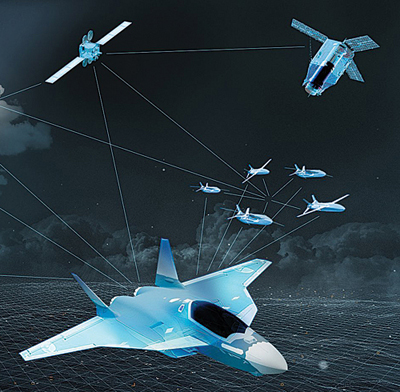INDIAN ARMED FORCES CHIEFS ON
OUR RELENTLESS AND FOCUSED PUBLISHING EFFORTS

SP Guide Publications puts forth a well compiled articulation of issues, pursuits and accomplishments of the Indian Army, over the years

I am confident that SP Guide Publications would continue to inform, inspire and influence.

My compliments to SP Guide Publications for informative and credible reportage on contemporary aerospace issues over the past six decades.
Artificial Intelligence in Military Aviation
NEWS
On a cloudless morning last May, a pilot took off from the Niagara Falls International Airport, heading for restricted military airspace over Lake Ontario. The aircraft which bore the insignia of the United States Air Force, was a Czechoslovak jet, an L-39 Albatros, purchased by a private defence contractor. The bay in front of the cockpit was filled with sensors and computer processors that recorded the aircraft’s performance. For two hours, the pilot flew counter clockwise around the lake. Engineers on the ground, under contract with DARPA, the Defence Department’s research agency, had choreographed every turn, every pitch and roll, in an attempt to do something unprecedented: design a plane that can fly and engage in aerial combat without a human pilot on the controls.

VIEWS:
Artificial intelligence (AI) is a wide-ranging branch of computer science concerned with the building of smart machines capable of performing tasks that typically require human intelligence. AI is therefore nothing but intelligence demonstrated by machines as opposed to natural intelligence displayed by human beings or even animals. AI is divided broadly into three categories that are Artificial Narrow Intelligence (ANI), Artificial General Intelligence (AGI) and Artificial Super Intelligence (ASI).
The concept of AI can be traced back in human history to the era of Greek mythology during which intelligent robots and artificial beings made their first appearance in writings in that period. While the roots of AI are long and deep, genuine and meaningful research in this field in the modern age began only in 1956 at a workshop at Dartmouth College which is a private research university in Hanover, New Hampshire in the United States (US). Scientists and engineers involved in the research programmes dealing with the development of the concept of AI in the initial years after its initiation that was in the 1960s, were convinced that even though the journey would be a long and arduous one, the effort to create machines with intelligence would eventually succeed. The scientists and engineers engaged in developing AI were of the view that within a time frame of twenty years, they would be able to develop machines that would be capable of doing any work that a human being could undertake.
By the middle of the 1960s, research in the US was being funded largely by the Department of Defence and the laboratories for research and experiments in this field had been established practically all around the world. However, in the year 1974, progress in the development of AI had slowed down considerably because success of the research projects to develop AI was very little and hence there was considerable pressure from the US Congress to divert funds from the development of AI to more useful and productive projects. As a result, the US government stopped the allocation of funds from the coffers of the government for exploratory research in AI. Unfortunately, the government of the United Kingdom (UK) followed the example set by the US and discontinued funding research projects related to AI.
It took quite some time before the US government understood the enormous potential of AI and especially of its relevance and application in the domain of the military. Thus it was that in the year 2018 that the Department of Defence of the US government established the Joint Artificial Intelligence Centre (JAIC) with the aim of exploiting the enormous potential of the technology in the domain of AI to bolster the national security of the nation. The JAIC thus became the official focal point of the strategy to develop AI for use by the Department of Defence of the US government. Over the years, the JAIC has inducted world class talent in the domain of AI to pursue its objectives related to national security.
Although, the US has emerged as the leader in the exploitation of AI especially for military application, AI has begun to drive the arms race across the world. Global spending on AI in the regime of military application in the year 2020 had exceeded six billion US dollars which is expected to grow exponentially in the future. Russia too has taken up the development of unmanned vehicles such as robotic tanks. China is not to be left behind in this race as large private research organisations have got involved in a big way with a growing number of collaborations between defence and academic institutions in the country. China has converted obsolete combat jets to operate as autonomous drones to launch suicide attacks against vital installations of the enemy on the ground. Such modified aircraft can also operate as swarms making it extremely difficult to defend against. The developments in China in the domain of AI would quite understandably be a matter of concern for not only the US, but for India as well. Even a tiny nation like Libya is reported to have launched an autonomous drone that appeared to be equipped with real-time image processing to identify and strike targets.
While the leading military powers across the globe are racing ahead in the regime of AI, India too has joined the race with some initiatives by the Indian Ministry of Defence on behalf of the government. In 2019, the Indian government constituted the Defence Artificial Intelligence Council (DAIC) under the Minister of Defence. The DAIC is responsible for providing strategic direction to the defence industry for the exploitation of AI.





